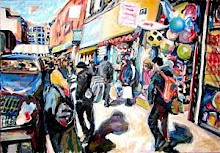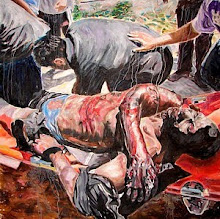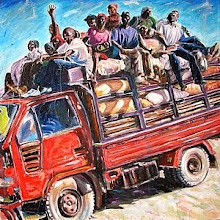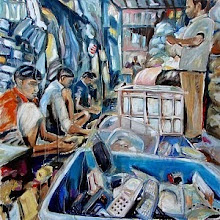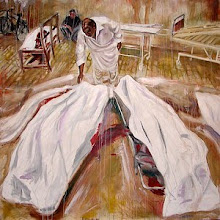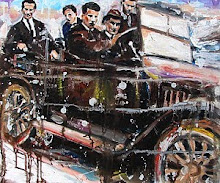Introduction
Eleanor Parker writes in her book, Winters in the World, that "in Anglo-Saxon poetry winter is often imagined as a season when the earth and human beings are imprisoned, kept captive by the 'fetters of the frost'. Naturally enough, then, spring is associated with images of liberation and freedom once those fetters are released." (p. 93) Even the title of the book, Winters in the World, described one's age, e.g. I have 30 winters in the world, a recognition of the harshness of the winters which one had survived.
Historically, the transition from winter to spring was symbolised by many traditions that reflected the end of difficult times and the coming of the new season of growth and rebirth. These traditions ranged from the celebration of vegetation deities through fertility rites, and the public rituals associated with Carnival/Fat Tuesday (February/March), Lent (February/March), Easter (fires/eggs/hares) (March/ April) and Rogation Days (April). Many rituals were taken over by the Christian church and given new meanings which themselves are now being secularised.
However, since the development of industrial farming in the early twentieth century, the connection between local farming and spring rituals associated with the land have declined and taken on a commercialised aspect separated from nature. We can see this with Carnival and Easter, while Lent fasting is not practised so much anymore.
This is not to say that the ending of the underlying reasons for carnival and the fasting of Lent, i.e. the finishing up of winter stocks and the privation until new crops grew, is such a bad thing, but our dependence on the current global system of industrial farming is worrying at a time when climate change is affecting food production around the world.
This change is also partly due to unsustainable agricultural methods that are negatively affecting our ability to farm in the future, for example, the spread of desertification, whereby fertile areas become arid due to the overexploitation of soil.
Furthermore, supermarkets packed to the gills with produce from all over the world deflects our attention from looming disasters. In Ireland we know the difference between famine (widespread scarcity of food) and hunger (in Irish Gaelic, An Gorta Mór, the great hunger) ... 'when a country is full of food and exporting it'.
Moreover, governmental measures to deal with land issues may be too little too late, or ineffective, as new laws are simply ignored by vested interests.
The Past
Vegetation Deities and Fertility Rites
From earliest times our relationship with nature had an element of awe and respect that resulted in the belief in vegetation deities "whose disappearance and reappearance, or life, death and rebirth, embodies the growth cycle of plants." Many vegetation deities were also considered fertility deities, that is, "a god or goddess associated with fertility, sex, pregnancy, childbirth, and crops."
In Mesopotamian culture (dating back to the mid-4th millennium BCE) religion "involved the worship of forces of nature as providers of sustenance" and which later became personified as a range of gods with different functions. Natural phenomena in nature were seen to be directed by nature spirits, thus:
"A nature deity can be in charge of nature, a place, a biotope, the biosphere, the cosmos, or the universe. Nature worship is often considered the primitive source of modern religious beliefs and can be found in pantheism, panentheism, deism, polytheism, animism, Taoism, totemism, Hinduism, shamanism, some theism and paganism".
In some cases the gods die and later return to life, particularly in religions of the ancient Near East. These dying-and-rising, death-rebirth, or resurrection deities are associated with the seasons as allegories of the death of nature and the rebirth of nature during spring, for example, Osiris, the god of fertility, agriculture, the afterlife, the dead, resurrection, life, and vegetation in ancient Egyptian religion, and Persephone in Greece, the goddess of spring and nature whose return from the underworld each spring is a symbol of her immortality.
Statue of syncretic Persephone-Isis with a sistrum. Heraklion Archaeological Museum, Crete
Similarly, many later Roman gods and goddesses were the subjects of fertility rites and celebrations. The festival of Liberalia was held on the 17th March to celebrate the spring growth. Liber was one of the original Roman gods. A favourite of the plebeians, he was the god of fertility and wine. His festival, the Liberalia, was an occasion to mark the return of life:
"The celebration was meant to honor Liber Pater, an ancient god of fertility and wine (like Bacchus, the Roman version of the Greek god Dionysus). Liber Pater was also a vegetation god, responsible for protecting seed. Again like Dionysus, he had female priestesses, but Liber's were older women known as Sacerdos Liberi. Wearing wreaths of ivy, they made special cakes, or libia, of oil and honey which passing devotees would have them sacrifice on their behalf. Over time this feast evolved and included the goddess Libera, and the feast divided so that Liber governed the male seed and Libera the female."
The Present
Carnival / Mardi Gras (Fat Tuesday) (February / March)
Of all the ancient festivals that survived into current times Carnival is probably the most prominent. Winter spirits have been forced out to make way for the new season since antiquity. Carnival symbolised this transition from winter to summer and darkness to light. The carnival was a feast whereby ordinary people feasted on the last of the winter stocks before they rotted. This in turn created the obligatory restraint and fasting until new produce was available. The Christian festival consists of Quinquagesima or Shrove Sunday, Shrove Monday, and Shrove Tuesday or Mardi Gras (Fat Tuesday). Therefore:
"Carnival typically involves public celebrations, including events such as parades, public street parties and other entertainments, combining some elements of a circus. Elaborate costumes and masks allow people to set aside their everyday individuality and experience a heightened sense of social unity. Participants often indulge in excessive consumption of alcohol, meat, and other foods that will be forgone during upcoming Lent."
The phrase 'Shrove Tuesday' comes from 'shrive' to be absolved of one's sins and therefore shriven before the start of Lent. It is also the last day of the Christian liturgical season which in French is known as Mardi Gras (Fat Tuesday) the last night of eating well before the ritual fasting beginning on the next day, Ash Wednesday.
Lent (February / March)
Lent begins on Ash Wednesday and lasts around six weeks. In this Christian religious observance, (according to the Gospels of Matthew, Mark and Luke) Jesus Christ spent 40 days fasting in the desert and enduring temptation by Satan. The word Lent comes from the lengthening days of spring and is considered a period of grief which ends with the celebrations of Easter.
Easter (March / April)
Easter is derived from pagan customs that celebrated the victory of Spring over Winter. They lit fires that helped to accelerate the end of Winter and spread the ashes over the fields to help fertilise the soil in fertility rites. Easter bonfires "have been a tradition in Germany since the 11 century. The Christians adopted the pagan custom and reinterpreted it. The fire was now seen as the light of Jesus, reminding people of the life and resurrection of Christ." The Christian festival commemorates the resurrection of Jesus from the dead after his crucifixion by the Romans at Calvary c. 30 AD. Easter is also called Pascha (Aramaic, Greek, Latin) or Resurrection Sunday.
Other cultural traditions associated with Easter include Easter parades, communal dancing (Eastern Europe), the Easter Bunny and egg hunting. It is likely that the eggs and the prodigious reproduction of rabbits and hares led to their depiction as symbols of fertility.
Rogation Days (April)
Rogation Days follow some weeks after Easter when processions are formed to to pray or beseech (Latin 'rogare') God for protection from from natural disasters such as hailstorms, floods, and droughts and to ask to ask for blessings on the fields. Rogation processions started at a very early date in order to counteract the Roman Robigalia processions that the pagans made in honor of their gods:
"The Robigalia was a festival in ancient Roman religion held April 25, named for the god Robigus. Its main ritual was a dog sacrifice to protect grain fields from disease. Games (ludi) in the form of "major and minor" races were held. The Robigalia was one of several agricultural festivals in April to celebrate and vitalize the growing season, but the darker sacrificial elements of these occasions are also fraught with anxiety about crop failure and the dependence on divine favor to avert it."
As can be seen in these regular prayers, blessings, and processions throughout the Spring season, the anxiety of the people regarding their crops shows a deep understanding of the vagaries of nature and an awareness of their lives dependence on the health of their cultivation work.
The Future
Industrial Farming
By the early twentieth century agriculture started to change due to new developments that brought in the era of industrial farming. Previously a wide variety of foods were produced by many small farms. However, that was all about to change as modern science was applied to various aspects of farming:
"In 1909, a scientific breakthrough by German chemist Fritz Haber—the "father of chemical warfare"—enabled the large-scale production of fertilizer (and explosives), igniting the industrialization of farming. Synthetic fertilizers, along with the development of chemical pesticides, allowed farmers to increase their crop yields (and their profits). Farmers began specializing in fewer crops, namely corn and soy, grown to feed farmed animals. Chickens became the first factory farmed animal when a farmer decided to try to raise ten times as many birds in a chicken house that was only built for 50. Other farmers followed suit."
Thus followed the new era of industrial farming. The effect of mass production led to the use of antibiotics, selective breeding to increase the size of farm animals, and the mechanisation of slaughter houses.
These developments led to the collapse of the many small farmers who could not compete with farming on an industrial scale. For example, now in the USA "small independent and family-run farms use only 8% of all agricultural land. In just under a century, and especially since the 1960s, agriculture has become dominated by large-scale multinational corporations. Driven by profit, these food giants rely on practices that, by design, exploit and abuse animals, destroy natural habitats, and generate pollution".
In more recent decades industrialisation has led to more innovations in "agricultural machinery and farming methods, genetic technology, techniques for achieving economies of scale in production, the creation of new markets for consumption, the application of patent protection to genetic information, and global trade."
This type of intensive farming has a low fallow ratio, and a high level of agrochemicals and water, producing higher crop yields per unit land area. Most of the meat, dairy products, eggs, fruits, and vegetables available in supermarkets are produced by such farms.
Costs to the Environment
Despite the current massive production of food globally, industrialized farming has costs that do not augur well for the future. It has been noted that intensive farming pollutes air and water (through the release of manure, chemicals, antibiotics, and growth hormones), destroys wildlife, facilitates the spread of viruses from animals to humans, fosters antimicrobial resistance, and is linked to epidemics of obesity and chronic disease, through the production of a wide variety of inexpensive, calorie-dense and widely available foods.
Regenerative Agriculture
The increasing awareness of the types of problems that intensive farming could be leading us to in the future is turning some farmers back to more traditional methods of farming. Regenerative agriculture focuses on "topsoil regeneration, increasing biodiversity, improving the water cycle, enhancing ecosystem services, supporting biosequestration, increasing resilience to climate change, and strengthening the health and vitality of farm soil." Regenerative agriculture also includes different philosophies of farming such as permaculture, agroecology, agroforestry, restoration ecology, crop rotation, and uses "no-till" and/or "reduced till" practices often described as sustainable farming.
Nature Restoration and Practice
The negative aspects of industrial farming have come to the notice of governmental bodies such as the EU parliament which has adopted a law to restore habitats and degraded ecosystems in all member states. It notes that "over 80% of European habitats are in poor shape" and "sets a target for the EU to restore at least 20% of the EU’s land and sea areas by 2030 and all ecosystems in need of restoration by 2050."
However, resistance to positive changes and procrastination deal serious blows to good intentions. The recent referral of Ireland to the EU Court of Justice for failing to halt the continued cutting of peat in areas designated to conserve raised bogs and blanket bogs is a good example. The infringement is one of the longest running infringement cases in Europe, having begun in 2010.
Conclusion
Our long running relationship with nature has benefited from science in the form of the production of plentiful food on a global scale. Yet our deep respect for nature in the past was partly due to our lack of understanding of the processes of biology which led to much anxiety and fear of starvation. All of the polytheistic and monotheistic debates over the influence of gods and goddesses or God have been replaced by scientific processes, but no less anxiety about the future of farming. Farming has always been reliant on predictability as plants are very sensitive to sudden climatic changes such as drought or frost, which can destroy a crop overnight (unseasonal frost) or slowly (extreme drought). Such incidences of crop failures are sporadic if examined on a global scale, but if these incidences multiply rapidly then we will see food price rises and their disastrous social consequences. A new respect for nature is called for that echoes down the centuries when those that did not heed the warnings witnessed the collapse of civilisations.
Caoimhghin Ó Croidheáin is an Irish artist, lecturer and writer. His artwork consists of paintings based on contemporary geopolitical themes as well as Irish history and cityscapes of Dublin. His blog of critical writing based on cinema, art and politics along with research on a database of Realist and Social Realist art from around the world can be viewed country by country here. Caoimhghin has just published his new book – Against Romanticism: From Enlightenment to Enfrightenment and the Culture of Slavery, which looks at philosophy, politics and the history of 10 different art forms arguing that Romanticism is dominating modern culture to the detriment of Enlightenment ideals. It is available on Amazon (amazon.co.uk) and the info page is here.





.jpg)








